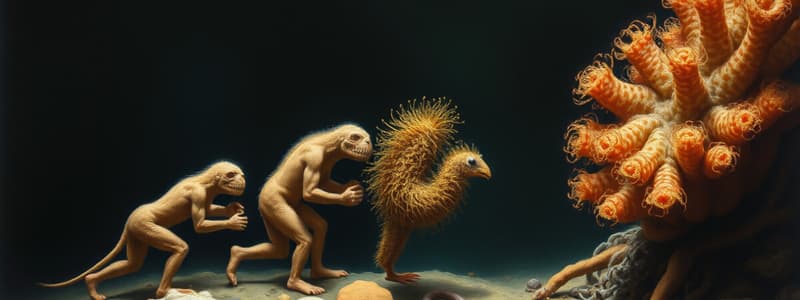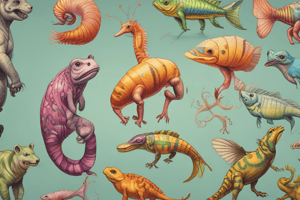Podcast
Questions and Answers
What type of organisms are tube sponges classified as?
What type of organisms are tube sponges classified as?
- Animals (correct)
- Plants
- Fungi
- Protists
What are some adaptations that evolved in invertebrates?
What are some adaptations that evolved in invertebrates?
- Tissues, organs, and organ systems (correct)
- Warm-blooded metabolism
- A body covered in scales
- Ability to produce feathers
Which of the following structures is similar between choanocytes and choanoflagellate protists?
Which of the following structures is similar between choanocytes and choanoflagellate protists?
- Cell wall structure
- Flagella (correct)
- Photosynthetic capabilities
- Gastrovascular cavity
What is theorized to be the ancestor of the earliest animals?
What is theorized to be the ancestor of the earliest animals?
Which of the following features is essential for the evolution of vertebrates?
Which of the following features is essential for the evolution of vertebrates?
When did most modern phyla of animals evolve?
When did most modern phyla of animals evolve?
Which of the following is NOT an adaptation associated with invertebrates?
Which of the following is NOT an adaptation associated with invertebrates?
Which animals were the first vertebrates to colonize land?
Which animals were the first vertebrates to colonize land?
What was one of the first adaptations that allowed early arthropods to survive on land?
What was one of the first adaptations that allowed early arthropods to survive on land?
What does a notochord provide to animals that possess it?
What does a notochord provide to animals that possess it?
Which group of vertebrates was the first to transition from water to land?
Which group of vertebrates was the first to transition from water to land?
What advantage did the evolution of amniotic eggs provide to terrestrial animals?
What advantage did the evolution of amniotic eggs provide to terrestrial animals?
What characterizes vertebrates that evolved from primitive chordates?
What characterizes vertebrates that evolved from primitive chordates?
Which statement is true about lobe-finned fish?
Which statement is true about lobe-finned fish?
Which two major groups of amniotes evolved shortly after the first fully terrestrial vertebrates emerged?
Which two major groups of amniotes evolved shortly after the first fully terrestrial vertebrates emerged?
The first animals to go ashore were primarily vertebrates.
The first animals to go ashore were primarily vertebrates.
A notochord is a rigid rod that runs along the length of the body of chordates.
A notochord is a rigid rod that runs along the length of the body of chordates.
Amphibians were the first animals to evolve true lungs and limbs for land.
Amphibians were the first animals to evolve true lungs and limbs for land.
Lobe-finned fish could not breathe air and were entirely aquatic.
Lobe-finned fish could not breathe air and were entirely aquatic.
Amniotes are vertebrates that lay eggs with internal membranes for protection against drying out.
Amniotes are vertebrates that lay eggs with internal membranes for protection against drying out.
The earliest vertebrates are thought to have been jawed fish.
The earliest vertebrates are thought to have been jawed fish.
Synapsids evolved into reptiles, dinosaurs, and birds.
Synapsids evolved into reptiles, dinosaurs, and birds.
Tube sponges are classified as fungi.
Tube sponges are classified as fungi.
The oldest animal fossils date back to approximately 630 million years ago.
The oldest animal fossils date back to approximately 630 million years ago.
Choanocyte cells in sponges do not resemble choanoflagellate protists.
Choanocyte cells in sponges do not resemble choanoflagellate protists.
Amphibians were the first vertebrates to colonize the land.
Amphibians were the first vertebrates to colonize the land.
Invertebrates played a role in the evolution of vertebrates through important adaptations.
Invertebrates played a role in the evolution of vertebrates through important adaptations.
The evolution of a brain and sensory organs is an adaptation that evolved in vertebrates only.
The evolution of a brain and sensory organs is an adaptation that evolved in vertebrates only.
The first multicellular animals likely evolved from marine protists that specialized cells for different functions.
The first multicellular animals likely evolved from marine protists that specialized cells for different functions.
Most modern phyla of animals were present 100 million years ago.
Most modern phyla of animals were present 100 million years ago.
Flashcards are hidden until you start studying
Study Notes
Tube Sponges and Animal Evolution
- Tube sponges are animals, identified as the simplest form of animal life on Earth.
- They provide shelter to various invertebrates like crabs and shrimps.
- The oldest known animal fossils date back about 630 million years.
Major Events in Animal Evolution
- By 500 million years ago, most modern animal phyla had emerged.
- Evolutionary milestones of animals are recorded on the geologic time scale.
Origins of Animals
- Earliest animals may have originated from marine protists that formed colonies.
- Specialized cells within protist colonies likely developed interdependence, leading to the first multicellular animals.
- Choanocyte sponge cells resemble choanoflagellate protists, supporting the hypothesis of animal ancestry from protists.
Invertebrate Evolution
- Significant adaptations began with invertebrates, allowing vertebrates to evolve.
- Key adaptations include:
- Development of tissues, organs, and organ systems.
- Symmetrical body structures.
- Development of a nervous system with a brain.
- Formation of a fluid-filled body cavity and complete digestive system.
- Body segmentation.
Transition from Water to Land
- Early land colonizers were invertebrates, particularly arthropods, not amphibians.
- Key adaptations for terrestrial survival included:
- Evolution of an exoskeleton for body support and moisture retention.
- Air-breathing capabilities replacing gills.
Evolution of Chordates
- The notochord, an internal support structure, signifies a major evolutionary advancement.
- Chordates also feature a hollow nerve cord, gill slits, and a tail during embryonic development.
- Early chordates include primitive tunicates.
Evolution of Vertebrates
- Vertebrates emerged from primitive chordates approximately 550 million years ago.
- The earliest vertebrates possibly included jawless fish like hagfish.
- Vertebrates developed backbones, craniums for brain protection, and progressed in complexity over time.
Transition to Terrestrial Life
- The first vertebrates to inhabit land were amphibians, evolving from lobe-finned fish around 365 million years ago.
- Lobe-finned fish had adaptations for brief land activity and air breathing.
Evolution of Amniotes
- Amniotes were the first fully terrestrial vertebrates, capable of laying eggs on land.
- Their eggs featured internal membranes that allowed gas exchange while retaining moisture.
- Earliest amniotes appeared about 350 million years ago, leading to synapsids (ancestors of mammals) and sauropsids (ancestors of reptiles, dinosaurs, and birds).
Tube Sponges and Animal Evolution
- Tube sponges are animals, identified as the simplest form of animal life on Earth.
- They provide shelter to various invertebrates like crabs and shrimps.
- The oldest known animal fossils date back about 630 million years.
Major Events in Animal Evolution
- By 500 million years ago, most modern animal phyla had emerged.
- Evolutionary milestones of animals are recorded on the geologic time scale.
Origins of Animals
- Earliest animals may have originated from marine protists that formed colonies.
- Specialized cells within protist colonies likely developed interdependence, leading to the first multicellular animals.
- Choanocyte sponge cells resemble choanoflagellate protists, supporting the hypothesis of animal ancestry from protists.
Invertebrate Evolution
- Significant adaptations began with invertebrates, allowing vertebrates to evolve.
- Key adaptations include:
- Development of tissues, organs, and organ systems.
- Symmetrical body structures.
- Development of a nervous system with a brain.
- Formation of a fluid-filled body cavity and complete digestive system.
- Body segmentation.
Transition from Water to Land
- Early land colonizers were invertebrates, particularly arthropods, not amphibians.
- Key adaptations for terrestrial survival included:
- Evolution of an exoskeleton for body support and moisture retention.
- Air-breathing capabilities replacing gills.
Evolution of Chordates
- The notochord, an internal support structure, signifies a major evolutionary advancement.
- Chordates also feature a hollow nerve cord, gill slits, and a tail during embryonic development.
- Early chordates include primitive tunicates.
Evolution of Vertebrates
- Vertebrates emerged from primitive chordates approximately 550 million years ago.
- The earliest vertebrates possibly included jawless fish like hagfish.
- Vertebrates developed backbones, craniums for brain protection, and progressed in complexity over time.
Transition to Terrestrial Life
- The first vertebrates to inhabit land were amphibians, evolving from lobe-finned fish around 365 million years ago.
- Lobe-finned fish had adaptations for brief land activity and air breathing.
Evolution of Amniotes
- Amniotes were the first fully terrestrial vertebrates, capable of laying eggs on land.
- Their eggs featured internal membranes that allowed gas exchange while retaining moisture.
- Earliest amniotes appeared about 350 million years ago, leading to synapsids (ancestors of mammals) and sauropsids (ancestors of reptiles, dinosaurs, and birds).
Studying That Suits You
Use AI to generate personalized quizzes and flashcards to suit your learning preferences.




